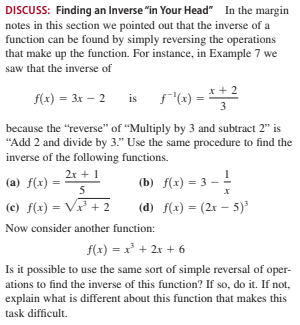DISCUSS: Finding an Inverse "in Your Head" In the margin notes in this section we pointed out that the inverse of a function can be found by simply reversing the operations that make up the function. For instance, in Example 7 we saw that the inverse of x + 2 f(x) = 3x – 2 is f'(x) 3 because the "reverse" of "Multiply by 3 and subtract 2" is "Add 2 and divide by 3." Use the same procedure to find the inverse of the following functions. 2x + 1 (a) f(x) (b) f(x) = 3 – ! 5 (c) f(x) = V + 2 (d) f(x) = (2x – 5)* Now consider another function: f(x) = x² + 2x + 6 Is it possible to use the same sort of simple reversal of oper- ations to find the inverse of this function? If so, do it. If not, explain what is different about this function that makes this task difficult.
DISCUSS: Finding an Inverse "in Your Head" In the margin notes in this section we pointed out that the inverse of a function can be found by simply reversing the operations that make up the function. For instance, in Example 7 we saw that the inverse of x + 2 f(x) = 3x – 2 is f'(x) 3 because the "reverse" of "Multiply by 3 and subtract 2" is "Add 2 and divide by 3." Use the same procedure to find the inverse of the following functions. 2x + 1 (a) f(x) (b) f(x) = 3 – ! 5 (c) f(x) = V + 2 (d) f(x) = (2x – 5)* Now consider another function: f(x) = x² + 2x + 6 Is it possible to use the same sort of simple reversal of oper- ations to find the inverse of this function? If so, do it. If not, explain what is different about this function that makes this task difficult.
Algebra and Trigonometry (MindTap Course List)
4th Edition
ISBN:9781305071742
Author:James Stewart, Lothar Redlin, Saleem Watson
Publisher:James Stewart, Lothar Redlin, Saleem Watson
Chapter2: Functions
Section2.8: One-to-one Functions And Their Inverses
Problem 103E
Related questions
Question

Transcribed Image Text:DISCUSS: Finding an Inverse "in Your Head" In the margin
notes in this section we pointed out that the inverse of a
function can be found by simply reversing the operations
that make up the function. For instance, in Example 7 we
saw that the inverse of
x + 2
f(x) = 3x – 2 is f'(x)
3
because the "reverse" of "Multiply by 3 and subtract 2" is
"Add 2 and divide by 3." Use the same procedure to find the
inverse of the following functions.
2x + 1
(a) f(x)
(b) f(x) = 3 – !
5
(c) f(x) = V + 2
(d) f(x) = (2x – 5)*
Now consider another function:
f(x) = x² + 2x + 6
Is it possible to use the same sort of simple reversal of oper-
ations to find the inverse of this function? If so, do it. If not,
explain what is different about this function that makes this
task difficult.
Expert Solution
This question has been solved!
Explore an expertly crafted, step-by-step solution for a thorough understanding of key concepts.
This is a popular solution!
Trending now
This is a popular solution!
Step by step
Solved in 4 steps with 4 images

Recommended textbooks for you

Algebra and Trigonometry (MindTap Course List)
Algebra
ISBN:
9781305071742
Author:
James Stewart, Lothar Redlin, Saleem Watson
Publisher:
Cengage Learning

College Algebra
Algebra
ISBN:
9781305115545
Author:
James Stewart, Lothar Redlin, Saleem Watson
Publisher:
Cengage Learning

Trigonometry (MindTap Course List)
Trigonometry
ISBN:
9781305652224
Author:
Charles P. McKeague, Mark D. Turner
Publisher:
Cengage Learning

Algebra and Trigonometry (MindTap Course List)
Algebra
ISBN:
9781305071742
Author:
James Stewart, Lothar Redlin, Saleem Watson
Publisher:
Cengage Learning

College Algebra
Algebra
ISBN:
9781305115545
Author:
James Stewart, Lothar Redlin, Saleem Watson
Publisher:
Cengage Learning

Trigonometry (MindTap Course List)
Trigonometry
ISBN:
9781305652224
Author:
Charles P. McKeague, Mark D. Turner
Publisher:
Cengage Learning